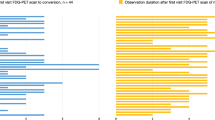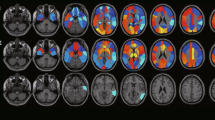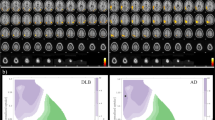Abstract
Purpose
This study was designed to examine the utility of visual inspection of medial temporal lobe (MTL) metabolism in the diagnosis of mild cognitive impairment (MCI) and Alzheimer’s disease (AD) using FDG-PET scans.
Methods
Seventy-five subjects [27 normal controls (NL), 26 MCI, and 22 AD] with FDG-PET and MRI scans were included in this study. We developed a four-point visual rating scale to evaluate the presence and severity of MTL hypometabolism on FDG-PET scans. The visual MTL ratings were compared with quantitative glucose metabolic rate (MRglc) data extracted using regions of interest (ROIs) from the MRI-coregistered PET scans of all subjects. A standard rating evaluation of neocortical hypometabolism was also completed. Logistic regressions were used to determine and compare the diagnostic accuracy of the MTL and cortical ratings.
Results
For both MTL and cortical ratings, high intra- and inter-rater reliabilities were found (p values <0.001). The MTL rating was highly correlated with and yielded a diagnostic accuracy equivalent to the ROI MRglc measures (p values <0.001). The combination of MTL and cortical ratings significantly improved the diagnostic accuracy over the cortical rating alone, with 100% of AD, 77% of MCI, and 85% of NL cases being correctly identified.
Conclusion
This study shows that the visual rating of MTL hypometabolism on PET is reliable, yields a diagnostic accuracy equal to the quantitative ROI measures, and is clinically useful and more sensitive than cortical ratings for patients with MCI. We suggest this method be further evaluated for its potential in the early diagnosis of AD.





Similar content being viewed by others
References
Hoffman EJ, Phelps ME. Positron emission tomography: principles and quantitation. In: Phelps ME, Mazziotta J, Schelbert H, editors. Positron emission tomography and autoradiography: principles and applications for the brain and heart. New York: Raven Press; 1986. p. 237–86
Herholz K, Perani D, Salmon E, Franck G, Fazio F, Heiss WD, et al. Comparability of FDG PET studies in probable Alzheimer’s disease. J Nucl Med 1993;34:1460–6
Minoshima S, Frey KA, Koeppe RA, Foster NL, Kuhl DE. A diagnostic approach in Alzheimer’s disease using three-dimensional stereotactic surface projections of fluorine-18-FDG PET. J Nucl Med 1995;36:1238–48
Herholz K, Salmon E, Perani D, Baron JC, Holthoff V, Frolich L, et al. Discrimination between Alzheimer dementia and controls by automated analysis of multicenter FDG PET. Neuroimage 2002;17:302–16
Silverman DHS, Small GW, Chang CY, Lu CS, Kung De Aburto MA, Chen W, et al. Positron emission tomography in evaluation of dementia: Regional brain metabolism and long-term outcome. JAMA 2001;286:2120–7
Hoffman JM, Welsh-Bohmer KA, Hanson M, Crain B, Hulette C, Earl N, et al. FDG PET imaging in patients with pathologically verified dementia. J Nucl Med 2000;41:1920–8
Silverman DHS, Truong CT, Kim SK, Chang CY, Chen W, Kowell AP, et al. Prognostic value of regional cerebral metabolism in patients undergoing dementia evaluation: comparison to a quantifying parameter of subsequent cognitive performance and to prognostic assessment without PET. Mol Genet Metab 2003;80:350–5
Petersen RC, Doody R, Kurz A, Mohs RC, Morris JC, Rabins PV, et al. Current concepts in mild cognitive impairment. Arch Neurol 2001;58:1985–92
Minoshima S, Giordani B, Berent S, Frey KA, Foster NL, Kuhl DE. Metabolic reduction in the posterior cingulate cortex in very early Alzheimer’s disease. Ann Neurol 1997;42:85–94
Chetelat G, Desgranges B, De La Sayette V, Viader F, Eustache F, Baron JC. Mild cognitive impairment: can FDG-PET predict who is to rapidly convert to Alzheimer’s disease? Neurology 2003;60:1374–7
Nestor PJ, Fryer TD, Smielewski P, Hodges JR. Limbic hypometabolism in Alzheimer’s disease and mild cognitive impairment. Ann Neurol 2003;54:343–51
Chetelat G, Desgranges B, De La Sayette V, Viader F, Berkouk K, Landeau B, et al. Dissociating atrophy and hypometabolism impact on episodic memory in mild cognitive impairment. Brain 2003;126:1955–67
Mosconi L, Perani D, Sorbi S, Herholz K, Nacmias B, Holthoff V, et al. MCI conversion to dementia and the APOE genotype: a prediction study with FDG-PET. Neurology 2004;63:2332–40
De Santi S, de Leon MJ, Rusinek H, Convit A, Tarshish CY, Roche A, et al. Hippocampal formation glucose metabolism and volume losses in MCI and AD. Neurobiol Aging 2001;22:529–39
de Leon MJ, Convit A, Wolf OT, Tarshish CY, DeSanti S, Rusinek H, et al. Prediction of cognitive decline in normal elderly subjects with 2-[18F]fluoro-2-deoxy-d-glucose/positron-emission tomography (FDG/PET). Proc Natl Acad Sci U S A 2001;98:10966–71
Reed BR, Jagust WJ, Seab JP, Ober BA. Memory and regional cerebral blood flow in mildly symptomatic Alzheimer’s disease. Neurology 1989;39:1537–9
Powers WJ, Perlmutter JS, Videen TO, Herscovitch P, Griffeth LK, Royal HD, et al. Blinded clinical evaluation of positron emission tomography for diagnosis of probable Alzheimer’s disease. Neurology 1992;42:765–70
Small GW, Okonek A, Mandelkern MA, La Rue A, Chang L, Khonsary A, et al. Age-associated memory loss: initial neuropsychological and cerebral metabolic findings of a longitudinal study. Int Psychogeriatr 1994;6:23–44
Berent S, Giordani B, Foster N, Minoshima S, Lajiness-O’Neill R, Koeppe R, et al. Neuropsychological function and cerebral glucose utilization in isolated memory impairment and Alzheimer’s disease. J Psychiatr Res 1999;33:7–16
McKelvey R, Bergman H, Stern J, Rush C, Zahirney G, Chertkow H. Lack of prognostic significance of SPECT Abnormalities in non-demented elderly subjects with memory loss. Can J Neurol Sci 1999;26:23–8
Ouchi Y, Nobezawa S, Okada H, Yoshikawa E, Futatsubashi M, Kaneko M. Altered glucose metabolism in the hippocampal head in memory impairment. Neurology 1998;51:136–42
de Leon MJ, McRae T, Rusinek H, Convit A, De Santi S, Tarshish C, et al. Cortisol reduces hippocampal glucose metabolism in normal elderly but not in Alzheimer’s disease. J Clin Endocrinol Metab 1997;82:3251–9
Mosconi L, Tsui WH, De Santi S, Li J, Rusinek H, Convit A, et al. Reduced hippocampal metabolism in mild cognitive impairment and Alzheimer’s disease: automated FDG-PET image analysis. Neurology 2005;64:1860–7
de Leon MJ, George AE, Golomb J, Tarshish C, Convit A, Kluger A, et al. Frequency of hippocampal formation atrophy in normal aging and Alzheimer’s disease. Neurobiol Aging 1997;1:1–11
Gomez-Isla T, Price JL, McKeel DW Jr, Morris JC, Growdon JH, Hyman BT. Profound loss of layer II entorhinal cortex neurons occurs in very mild Alzheimer’s disease. J Neurosci 1996;16:4491–500
Delacourte A, David JP, Sergeant N, Buee L, Wattez A, Vermersch P, et al. The biochemical pathway of neurofibrillary degeneration in aging and Alzheimer’s disease. Neurology 1999;52:1158–65
Rusinek H, De Santi S, Frid D, Tsui WH, Tarshish CY, Convit A, et al. Regional brain atrophy rate predicts future cognitive decline: 6-year longitudinal MR imaging study of normal aging. Radiology 2003;229:691–6
Jack CR, Shiung MM, Gunter JL, O’Brien PC, Weigand SD, Knopman DS, et al. Comparison of different MRI brain atrophy rate measures with clinical disease progression in AD. Neurology 2004;62:591–600
de Leon MJ, Golomb J, Convit A, De Santi S, McRae TD, George AE. Measurement of medial temporal lobe atrophy in diagnosis of Alzheimer’s disease. Lancet 1993;341:125–6
Killiany RJ, Hyman BT, Gomez-Isla T, Moss MB, Kikinis R, Jolesz F, et al. MRI measures of entorhinal cortex vs hippocampus in preclinical AD. Neurology 2002;58:1188–96
Vermersch P, Leys D, Scheltens P, Barkhof F. Visual rating of hippocampal atrophy: correlation with volumetry. J Neurol Neurosurg Psychiatry 1994;57:1015
de Leon MJ, Golomb J, George AE, Convit A, Tarshish CY, McRae T, et al. The radiologic prediction of Alzheimer’s disease: the atrophic hippocampal formation. Am J Neuroradiol 1993;14:897–906
Korf ESC, Wahlund L-O, Visser PJ, Scheltens P. Medial temporal lobe atrophy on MRI predicts dementia in patients with mild cognitive impairment. Neurology 2004;63:94–100
Hachinski VC, Iliff LD, Zilhka E, Du Boulay GH, McAllister VL, Marshall J, et al. Cerebral blood flow in dementia. Arch Neurol 1975;32:632–7
American Psychiatric Association. Diagnostic and statistical manual of mental disorders. 4th ed. Washington, D.C.: American Psychiatric Association; 1994
Reisberg B, Ferris SH, de Leon MJ, Crook T. The global deterioration scale for assessment of primary degenerative dementia. Am J Psychiat 1982;139:1136–9
Folstein M. The Mini-Mental State Examination. In: Crook T, Ferris SH, Bartus R, editors. Assessment in geriatric psychopharmacology. New Canaan: Mark Powley Associates; 1983. p. 47–51
McKhann G, Drachman D, Folstein M, Katzman R, Price D, Stadlan EM. Clinical diagnosis of Alzheimer’s disease: report of the NINCDS–ADRDA work group under the auspices of Department of Health & Human Services Task Force on Alzheimer’s disease. Neurology 1984;34:939–44
Gilbert JG, Levee RF, Catalano FL. A preliminary report on a new memory scale. Percept Motor Skills 1968;27:277–8
Wechsler D. Wechsler Adult Intelligence Scale—Revised. New York: Harcourt Brace Jovanovich; 1981
Flicker C, Ferris SH, Reisberg B. A two-year longitudinal study of cognitive function in normal aging and Alzheimer’s disease. J Geriat Psychiat Neurol 1993;6:84–96
Tsui WH, Rusinek H, Van Gelder P, Lebedev S. Analyzing multi-modality tomographic images and associated regions of interest with MIDAS. Proc SPIE Med Imaging: Image Processing 2001;4322:1725–34
Woods RP, Mazziotta JC, Cherry SR. MRI–PET registration with automated algorithm. J Comput Assist Tomogr 1993;17:536–46
Sokoloff L, Reivich M, Kennedy C, Des Rosiers MH, Patlak CS, Pettigrew KD, et al. The [14C]deoxyglucose method for the measurement of local cerebral glucose utilization: theory, procedure, and normal values in the conscious and anesthetized albino rat. J Neurochem 1977;28:897–916
Reivich M, Alavi A, Wolf A, Fowler J, Russell J, Arnett C, et al. Glucose metabolic rate kinetic model parameter determination in humans: the lumped constants and rate constants for [18F]fluorodeoxyglucose and [11C]deoxyglucose. J Cereb Blood Flow Metab 1985;5:179–92
Insausti R, Tunon T, Sobreviela T, Insausti AM, Gonzalo LM. The human entorhinal cortex: a cytoarchitectonic analysis. J Comp Neurol 1995;355:171–98
Amaral DG, Insausti R. Hippocampal formation. In: Paxinos G, editor. The human nervous system. San Diego: Academic Press; 1990. p. 711–55
Bobinski M, de Leon MJ, Wegiel J, Desanti S, Convit A, Saint Louis LA, et al. The histological validation of post mortem magnetic resonance imaging-determined hippocampal volume in Alzheimer’s disease. Neurosci 2000;95:721–5
Bobinski M, de Leon MJ, Convit A, De Santi S, Wegiel J, Tarshish CY, et al. MRI of entorhinal cortex in mild Alzheimer’s disease. Lancet 1999;353:38–40
Minoshima S, Frey KA, Foster NL, Kuhl DE. Preserved pontine glucose metabolism in Alzheimer’s disease: a reference region for functional brain image (PET) analysis. J Comput Assist Tomogr 1995;19:541–7
Bartko JJ, Carpenter WT. On the methods and theory of reliability. J Nerv Mental Dis 1976;163:307–17
Mosconi L. Brain glucose metabolism in the early and specific diagnosis of Alzheimer’s disease. Eur J Nucl Med Mol Imaging 2005;32:486–510
Friston KJ, Frith CD, Liddle PF, Frackowiak RS. Comparing functional (PET) images: the assessment of significant change. J Cereb Blood Flow Metab 1991;11:690–9
Convit A, de Leon MJ, Tarshish C, De Santi S, Tsui W, Rusinek H, et al. Specific hippocampal volume reductions in individuals at risk for Alzheimer’s disease. Neurobiol Aging 1997;2:131–8
Meltzer CC, Bryan NR, Holcomb HH, Kimball AW, Mayberg HS, Sadzot B, et al. Anatomical localization for PET using MRI imaging. J Comput Assist Tomogr 1990;14:418–26
Ibanez V, Pietrini P, Alexander GE, Furey ML, Teichberg D, Rajapakse JC, et al. Regional gluose metabolic abnormalities are not the result of atrophy in Alzheimer’s disease. Neurology 1999;50:1585–93
Carrington Reid M, Lachs MS, Feinstein AR. Use of methodological standards in diagnostic test research. Getting better but still not good. JAMA 1995;274:645–51
Acknowledgements
We thank the NIH–NIA for support of AG12101, AG13613, and AG08051. We thank Joanna Fowler, David Schlyer, and Gene-Jack Wang for support of the PET studies, and Schantel Williams and Ronit Notkin for study coordination and psychometric testing.
Author information
Authors and Affiliations
Corresponding author
Rights and permissions
About this article
Cite this article
Mosconi, L., De Santi, S., Li, Y. et al. Visual rating of medial temporal lobe metabolism in mild cognitive impairment and Alzheimer’s disease using FDG-PET. Eur J Nucl Med Mol Imaging 33, 210–221 (2006). https://doi.org/10.1007/s00259-005-1956-z
Received:
Accepted:
Published:
Issue Date:
DOI: https://doi.org/10.1007/s00259-005-1956-z




